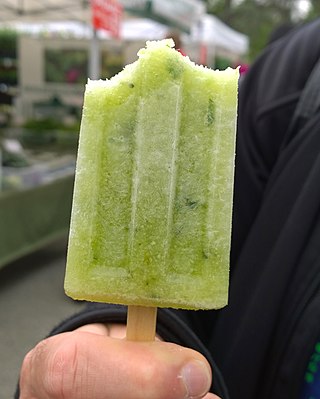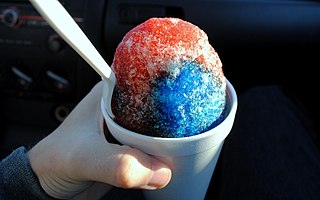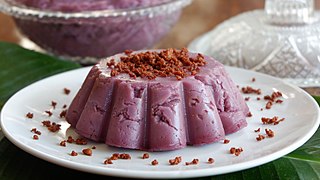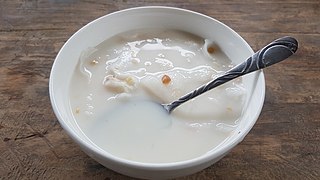Related Research Articles

Nata de coco, also marketed as coconut gel, is a chewy, translucent, jelly-like food produced by the fermentation of coconut water, which gels through the production of microbial cellulose by Komagataeibacter xylinus.

Filipino cuisine is composed of the cuisines of more than a hundred distinct ethnolinguistic groups found throughout the Philippine archipelago. A majority of mainstream Filipino dishes that compose Filipino cuisine are from the food traditions of various ethnolinguistic groups and tribes of the archipelago, including the Ilocano, Pangasinan, Kapampangan, Tagalog, Bicolano, Visayan, Chavacano, and Maranao ethnolinguistic groups. The dishes associated with these groups evolved over the centuries from a largely indigenous base shared with maritime Southeast Asia with varied influences from Chinese, Spanish, and American cuisines, in line with the major waves of influence that had enriched the cultures of the archipelago, and adapted using indigenous ingredients to meet local preferences.

Halo-halo, also spelled haluhalo, Tagalog for "mixed", is a popular cold dessert in the Philippines made up of crushed ice, evaporated milk or coconut milk, and various ingredients including side dishes such as ube jam, sweetened kidney beans or garbanzo beans, coconut strips, sago, gulaman (agar), pinipig, boiled taro or soft yams in cubes, flan, slices or portions of fruit preserves and other root crop preserves. The dessert is topped with a scoop of ube ice cream. It is usually prepared in a tall clear glass and served with a long spoon. Halo-halo is considered to be the unofficial national dessert of the Philippines.

An ice pop is a liquid/cream-based frozen dessert on a stick. Unlike ice cream or sorbet, which are whipped while freezing to prevent ice crystal formation, an ice pop is frozen while at rest, becoming a solid block of ice. The stick is used as a handle to hold it. Without a stick, the frozen product would be a freezie.

Shaved ice is a large family of ice-based desserts made of fine shavings of ice and sweet condiments or syrups. Usually, the syrup is added after the ice has been frozen and shaved—typically at the point of sale; however, flavoring can also be added before freezing. The dessert is consumed worldwide in various forms and ways. Shaved ice can also be mixed with large quantities of liquid to produce shaved ice drinks.

Maíz con hielo is a shaved ice dessert from the Philippines made with boiled corn kernels, sugar, and milk.

Buko pie, sometimes anglicized as coconut pie, is a traditional Filipino baked young coconut (malauhog) pie. It is considered a specialty in the city of Los Baños, Laguna located on the island of Luzon.

Binignit is a Visayan dessert soup from the central Philippines. The dish is traditionally made with glutinous rice cooked in coconut milk with various slices of sabá bananas, taro, ube, and sweet potato, among other ingredients. It is comparable to various dessert guinataán dishes found in other regions such as bilo-bilo. Among the Visayan people, the dish is traditionally served during Good Friday of Holy Week.

Ube halaya or halayang ube is a Philippine dessert made from boiled and mashed purple yam. Ube halaya is the main base in ube/purple yam flavored-pastries and ube ice cream. It can also be incorporated in other desserts such as halo-halo. It is also commonly anglicized as ube jam, or called by its original native name, nilupak na ube.

Filipino American cuisine has been present in America ever since Filipinos moved there, but only recently has the Filipino food become more widely popular. Filipino food has gone through its evolution of adapting other cultures' food practices into their own, or borrowing the food concept into their own.

Samalamig, also known as palamig, is a collective term for various Filipino sweet chilled beverages that usually include jelly-like ingredients. They come in various flavors, and are commonly sold by street vendors as refreshments. Typical ingredients of the drinks include gulaman (agar), sago pearls, kaong, tapioca pearls, nata de coco, and coconut. They are usually anglicized as pearl coolers or pearl and jelly coolers.

Minatamis na saging is a Filipino dessert made with chopped saba bananas cooked in a sweet syrup (arnibal) made with muscovado sugar and water. Some recipes also add a little bit of salt and pandan leaf or vanilla extract. Other ingredients can also be added like sweet potato, sago, or other fruits like jackfruit. It can be eaten on its own or added as an ingredient to other desserts. Adding the dessert over milk and shaved ice also results in another dessert known as saba con yelo.

Buko salad, usually anglicized as young coconut salad, is a Filipino fruit salad dessert made from strips of fresh young coconut (buko) with sweetened milk or cream and various other ingredients. It is one of the most popular and ubiquitous Filipino desserts served during celebrations and fiestas.

Lamaw, also known as buko lamaw, is a Filipino dessert or beverage made from scraped young coconut meat (buko) in coconut water with milk and sugar, and saltines or biscuits. Variations can add ingredients like peanuts, graham crackers, or orange-flavored softdrinks. Ice cubes are also commonly added to chill the dessert. It is usually made from freshly gathered coconuts, and is commonly served within the coconut shell itself. It originates from the Visayas and Visayan areas of Mindanao and is a traditional merienda for farmers working in the fields in rural areas.

Iskrambol, also known as ice scramble, is a Filipino frozen dessert made from shaved ice with banana extract and evaporated milk with sugar It is then topped with a variety of ingredients including powdered milk, marshmallows, strawberry syrup, chocolate syrup, pinipig, tapioca pearls, and sprinkles, among others. The regular banana extract flavored dessert is characteristically dyed pink while other flavors may be dyed accordingly.

Ube ice cream is a Filipino ice cream flavor prepared using ube as the main ingredient. This ice cream is often used in making the dessert halo-halo.

Avocado and milk in ice is a traditional Filipino dessert or beverage made from avocado in milk and sugar. It is preferably eaten cold. Ice are added, or it is partly frozen before consumption. The milk can also be excluded, mixing avocados directly with sugar. The avocados can also be mashed or puréed, which is usually called avocado milkshake or avocado smoothie. Sliced dessert bananas are sometimes added.
References
- ↑ Liwag, Lina. ""Ice Buko" (Coconut Popsicle)". Fresh n Crunchy. Retrieved April 23, 2019.
- ↑ "Buko Ice Candy". Kawaling Pinoy Tasty Recipes. Retrieved April 23, 2019.
- 1 2 "Coconut Popsicles (Filipino Ice Buko)". The Unlikely Baker. August 8, 2016. Retrieved April 23, 2019.
- ↑ "Bulacan takes pride in Negosyo". PhilStar Global. Retrieved April 23, 2019.
- ↑ Joven, Eduardo. "Special Buko Ice Candy: A Pinoy Favorite Summer Dessert". ChoosePhilippines. Archived from the original on December 7, 2018. Retrieved April 23, 2019.
